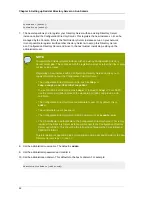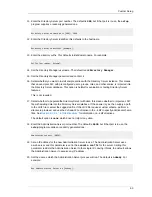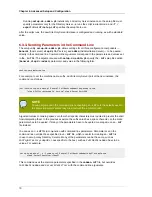
Typical Setup
59
To use TLS/SSL, set the protocol as
ldaps://
instead of
ldap://
For LDAPS,
use the secure port (636) instead of the standard port (389), and provide a CA
certificate.
• The Configuration Directory Server administrator's user ID; by default, this is
admin
.
• The administrator user's password.
• The Configuration Directory Server Admin domain, such as
example.com
.
• The CA certificate to authenticate to the Configuration Directory Server. This is only
required if the Directory Server instance will connect to the Configuration Directory
Server over LDAPS. This should be the full path and filename the CA certificate in
PEM/ASCII format.
This information is supplied in place of creating an admin user and domain for the new
Directory Server, steps
8
,
9
, and
10
.
8. Set the administrator username. The default is
admin
.
9. Set the administrator password and confirm it.
10. Set the administration domain. This defaults to the host's domain. For example:
Administration Domain [example.com]:
11. Enter the Directory Server port number. The default is
389
, but if that port is in use, the
setup
program supplies a randomly generated one.
Directory server network port [30860]: 1025
12. Enter the Directory Server identifier; this defaults to the hostname.
Directory server identifier [example]:
13. Enter the directory suffix. This defaults to
dc=
domain name
. For example:
Suffix [dc=redhat, dc=com]:
14. Set the Directory Manager username. The default is
cn=Directory Manager
.
15. Set the Directory Manager password and confirm it.
16. Enter the Administration Server port number. The default is
9830
, but if that port is in use, the
setup
program supplies a randomly generated one.
















































